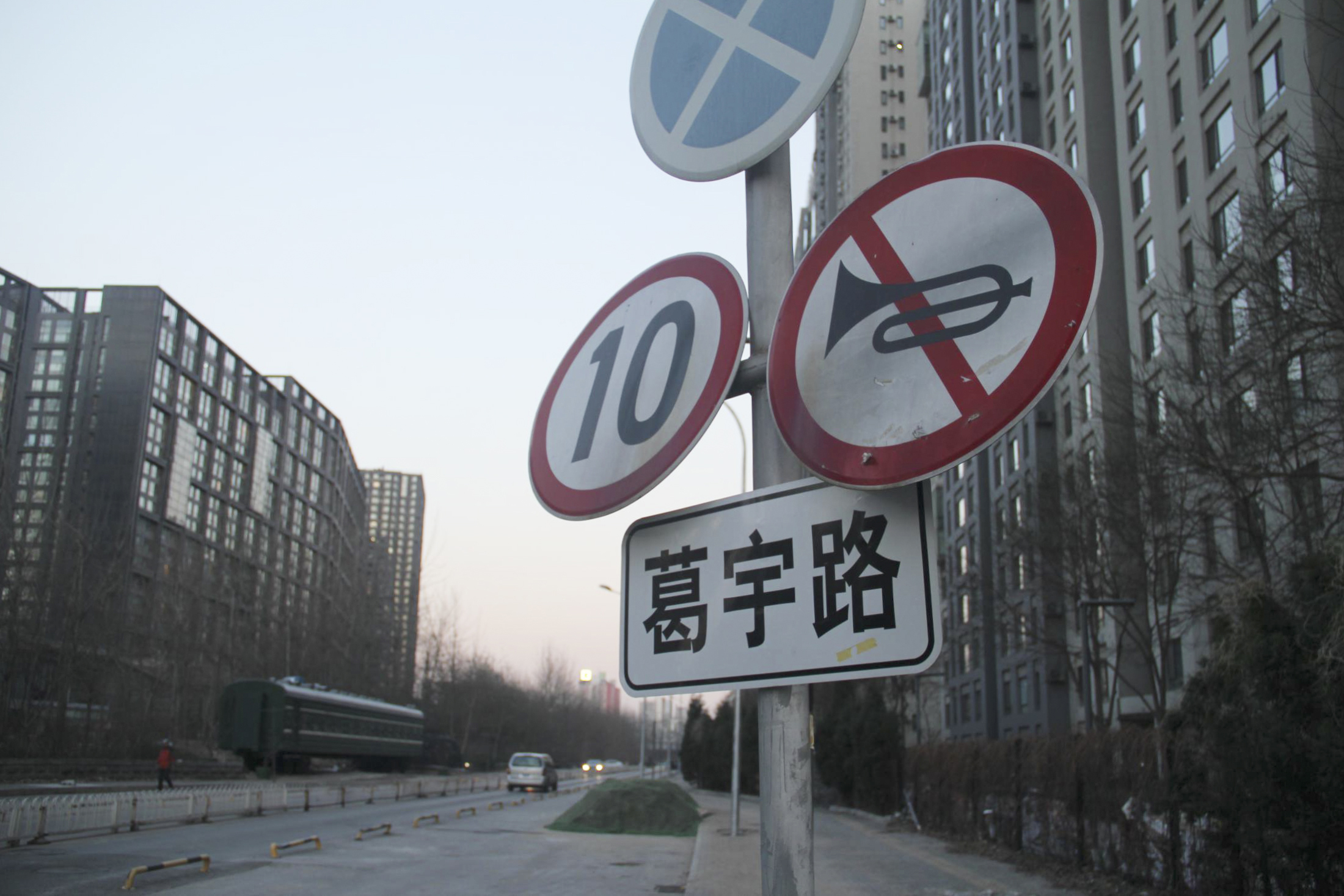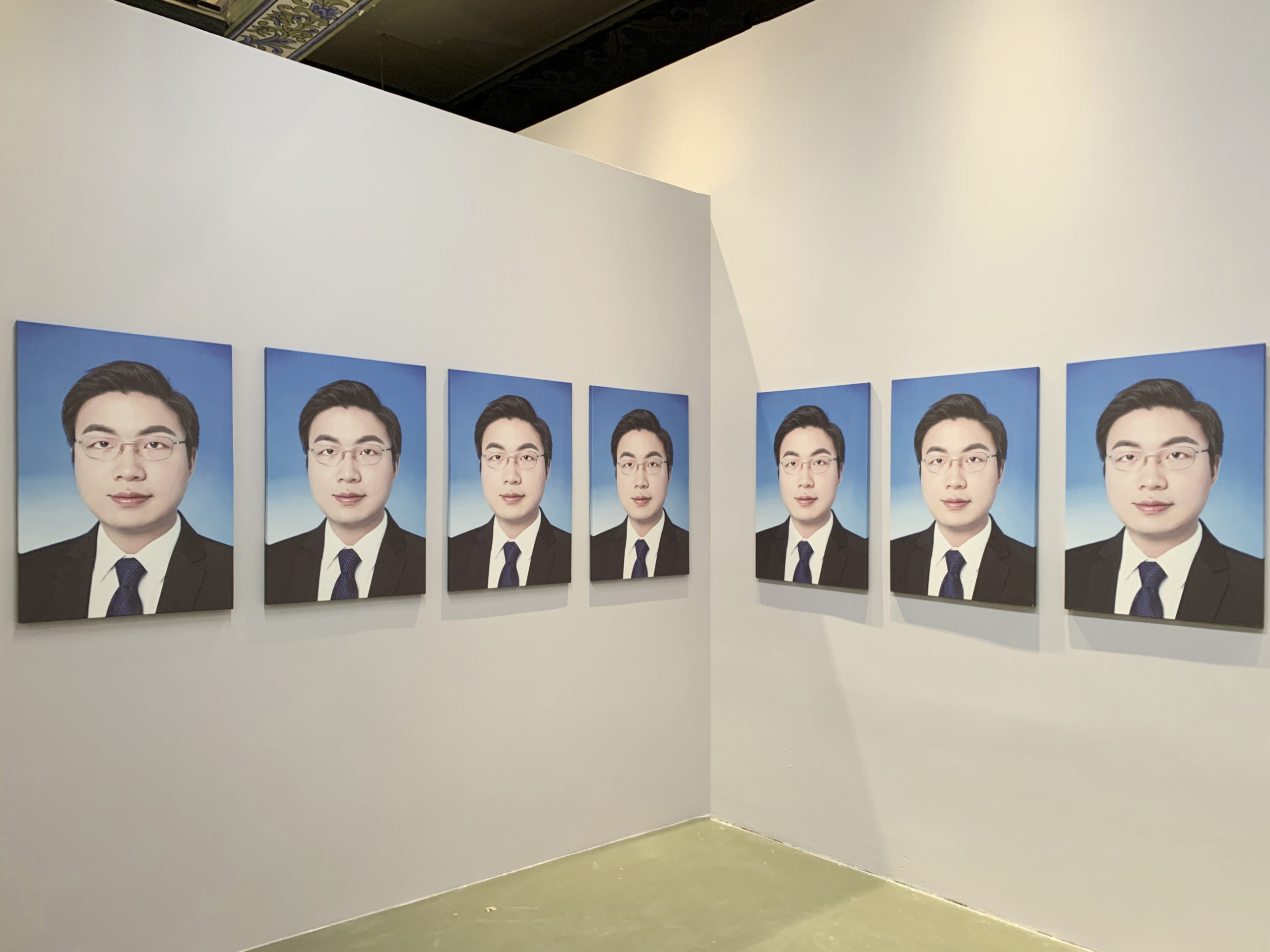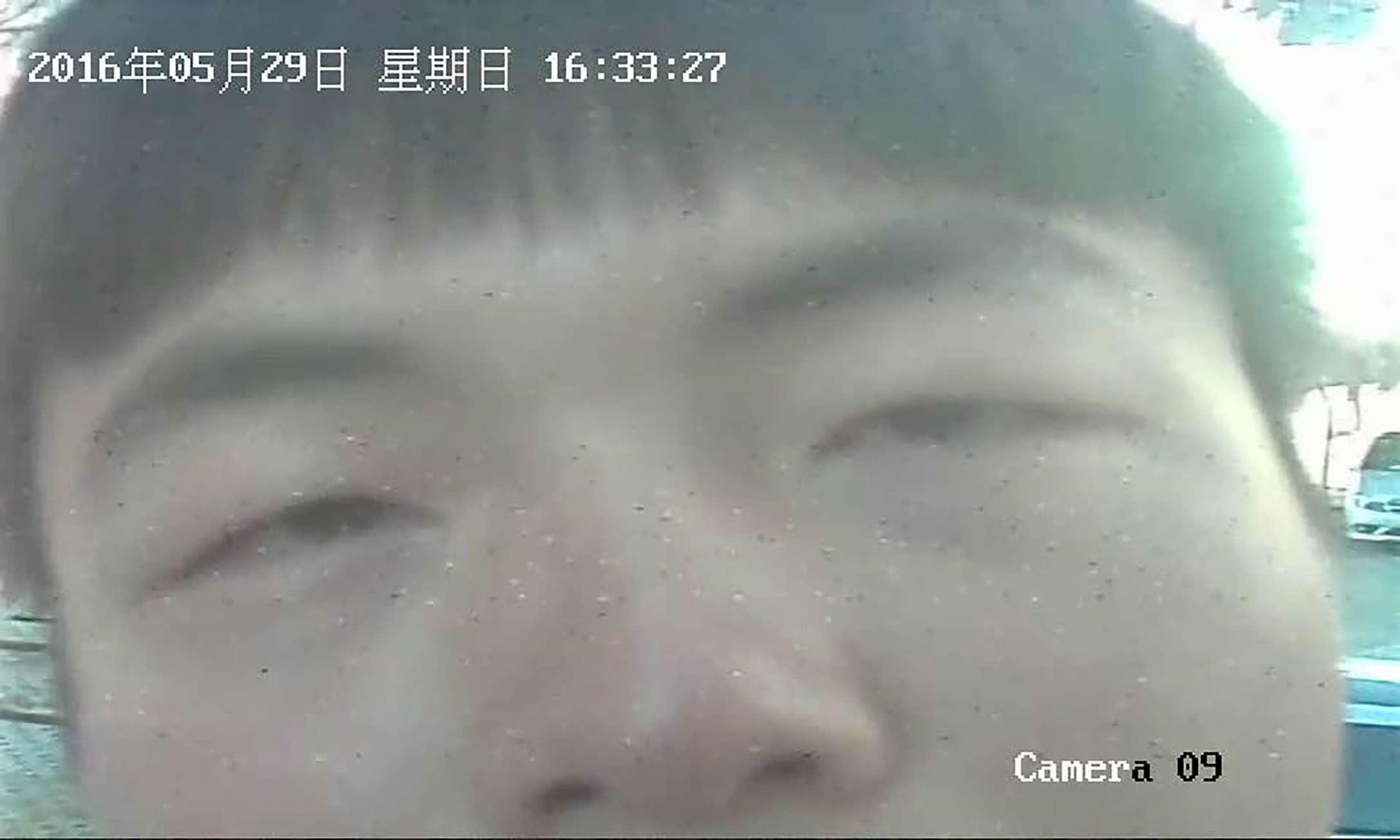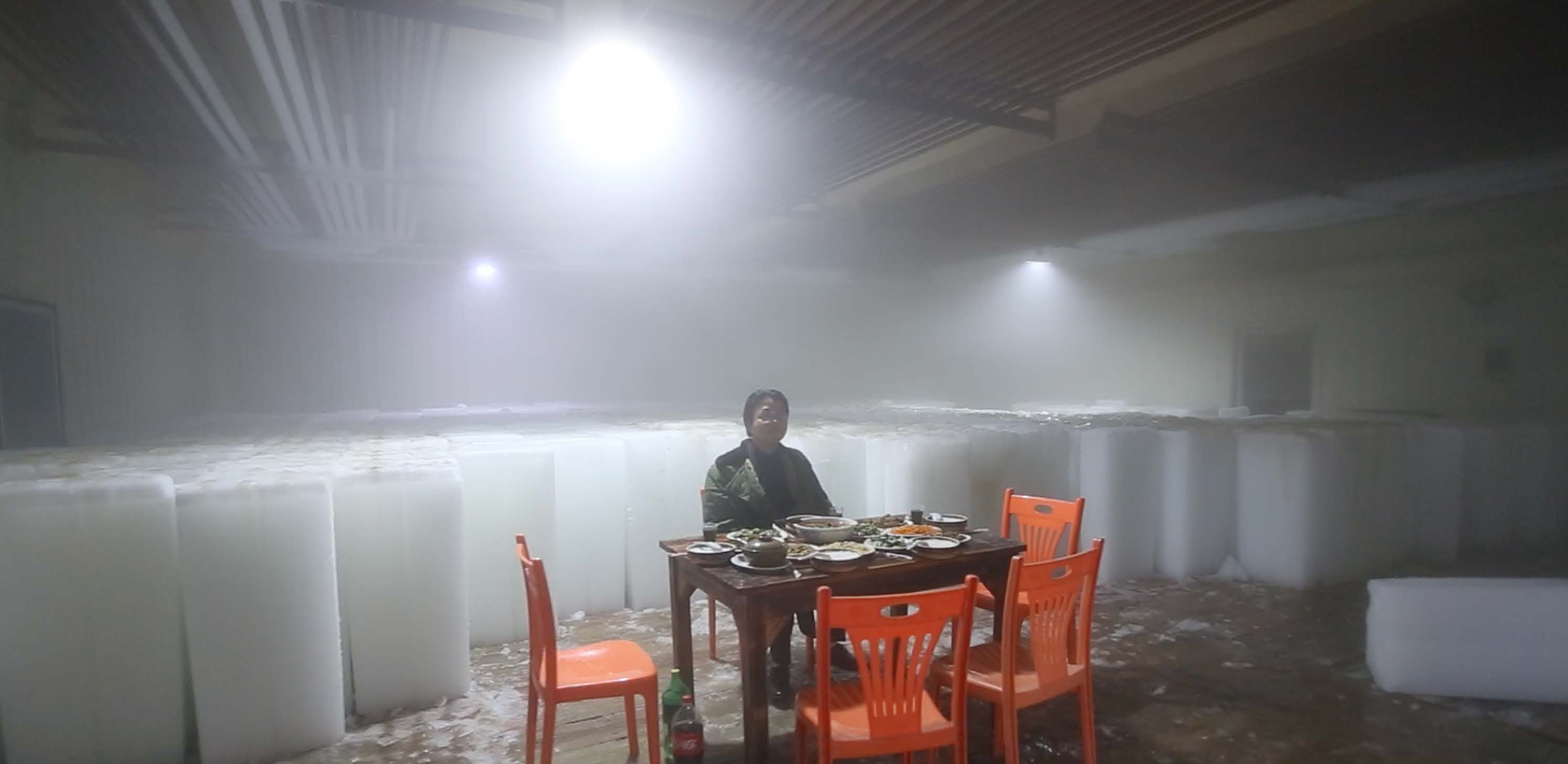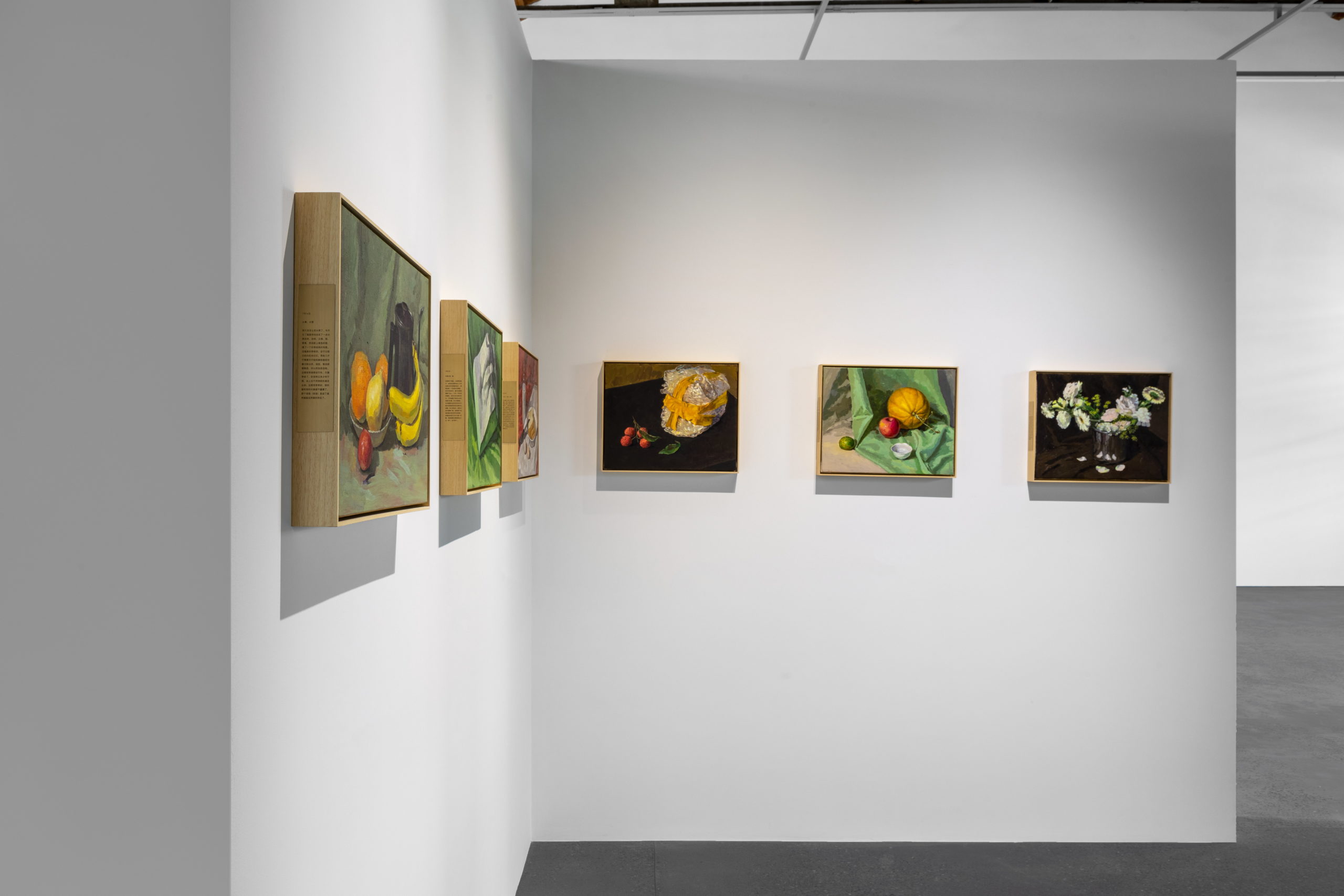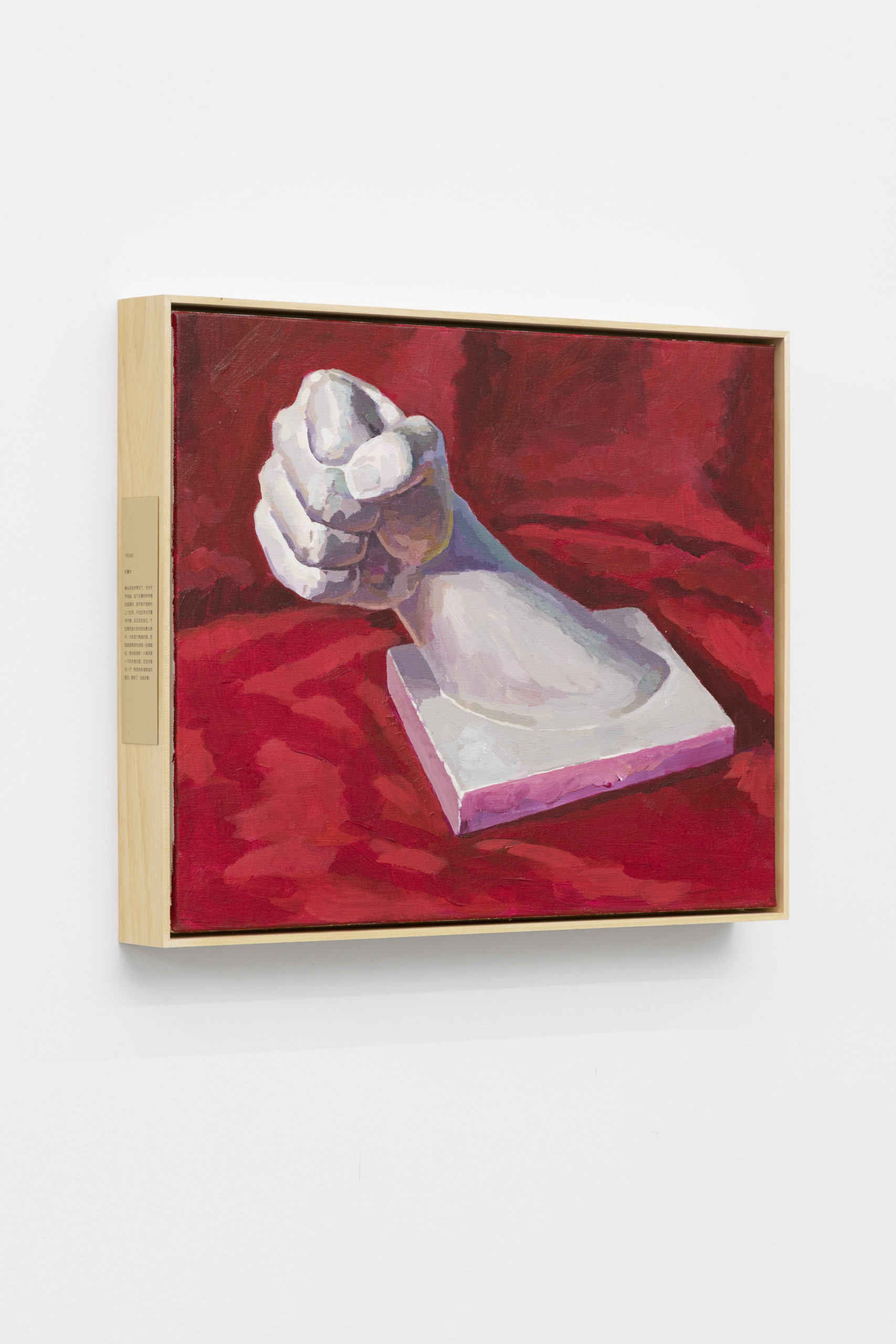Ge Yulu: Cutting In—Dances with the State and the Collective
Ge Yulu, Eye Contact, 2016, single-channel video, photograph, 2hours 14minutes 52seconds, 11.02 x 16.54 inches [courtesy of the artist]
Share:
In 2017 Ge Yulu became a national sensation in China. That year, he submitted his final project as a student at the Central Academy of Fine Arts in Beijing, revealing the unnamed road in Beijing that he had claimed in 2014 as his own. Because the Lu character in his name means road, he erected a sign for Geyu Road that blended seamlessly into the setting. Geyu Road soon appeared on AutoNavi, the Chinese equivalent of Google Maps, and on Google Maps itself.
Once the project became public knowledge, it caused a media storm, with positive coverage even from China Central Television (CCTV), an official Chinese government broadcast network. But soon enough, authorities clamped down and installed four street signs along the 400-meter stretch of asphalt, renaming Geyu Road to Baiziwannanyi Road. “When I saw the news photo, I found it very interesting that they made one sign for every 100 meters, as if they wanted to suppress something there,” Ge told writer Charlotte Gao in The Diplomat.
Ge Yulu’s artistic practice playfully pulls at the strings of a social system that, although seemingly all-encompassing, is in fact a malleable structure consisting of individual human beings. For his 2016 project Eye Contact, Ge positioned himself in front of a surveillance camera and stared directly into the lens for hours, then negotiated with a security guard to buy the footage. “It represented the elimination of the barriers separating us,” Ge told Ding Yining and Shi Yangkun for Sixth Tone. “When the guy copied the clip for me, he was no longer part of the system.”
Stephanie Bailey: Let’s begin with your early projects, when you began to interrogate your role as an artist, to find out where the line is, and push.
Ge Yulu: I’ve been thinking about this lately. In my early days, I would sense that there were things others could do that I couldn’t. In an unequal society where status determines your opportunities and rights, people in positions of authority will be given powers and privileges, while others can only stand aside and watch, regardless of how idiotic [the actions of the privileged] may be. It’s very much a matter of social status, which erases the possibility of a conversation between equals.
Slowly, I’ve been looking into the reasons for these discrepancies, and art has become a means to open that conversation. Art tends to generate dialogue, and I think that’s very important.
Ge Yulu, ⾏为, 2013 – 2017, performance [courtesy of the artist]
SB: That dialogue really expanded with the Ge Yulu project. Did you know the intervention was going to explode into public consciousness the way it did?
GY: I can’t say I planned for the project to unfold as it did, or that at any given point I was a hundred percent certain about what I was doing, but gradually I got a sense it would land in an area that would be interesting to explore. It’s a line of inquiry that has remained an open question. If you were to ask whether the average citizen has the right to install a street sign, there is no obvious answer. Historically speaking, these signs were placed by the average person, or the result of a collective endeavor. Only, today, we have given up this power to governments.
SB: Did you expect the national media reaction?
GY: I knew there would be a reaction, but I never expected it to blow up like this. Normally the Chinese government has the capacity to censor the media, but oddly mainstream media chose to partake and open the conversation to the public. But honestly, the coverage was less interesting to me than the reaction it generated. Many people did the same thing, and their road signs appeared across the country. I’m happy about this, as it reflects collective action. I don’t want people to think that they do not have the right to do the same as me. Because I could, they can too. That’s what I hope for.
Conversations in China tend to revolve around the same things: first, regarding governmental inaction, or the relationship between political history and individual endeavors; and, second, whether a person has the right to intervene to highlight the government’s shortcomings. Personally I am more affected by the relationship between individual and collective. The way I partake is almost like the way a hacker would infiltrate a system, which is more effective than attacking it from the outside.
Ge Yulu, Untitled, 2019, digital print on canvas, spray, wood frame, performance, 33.86 x 23.62 inches (a set of 18 pieces) [courtesy of the artist]
SB: You really demonstrated how the system could be played with, and you did [so] with this lightness, too, like with Sweeter (2012), when you threw some sugar into a lake to make it sweeter for everyone.
GY: I do often discuss with others whether these works enact a sort of resistance, but compared to previous generations, it will always be softer. I use humor to counter the collective fear towards the system. As you have said, with the lake, the addition of sugar will at least make it a bit sweeter. Our generation cannot anticipate the promise of radical change, but if everyone partakes and plays a small part, then maybe this will pass, too.
SB: Thinking about the work that came before the Ge Yulu project—such as Security Check (2013), when you scaled a building until you found a way to enter it—you performed the idea of disrupting a closed-network system as a single body.
GY: It’s more about the transition from body to identity, which is very present in my work. I have noticed that identity can help mobilize collective endeavors. Whereas using the body recalls a fine art training, identity helps establish a commonality between people which propels the imagination towards mass action.
SB: You played with this idea of identity when you became Ge Yulu the road, not the person; you take on an identity in order to disarm, which relates to Eye Contact, when you stared into a public surveillance camera for hours and then bought the footage. There’s this real intimacy to that act, like you are dancing with the state and the collective at once, because of what the security camera represents: at once the eye of Big Brother and the eye of the people.
GY: Previous generations tend to discuss these issues by looking in from the outside. But I treat it as if the state and I are one and the same. Not only am I a part of it, but I am also aware that the collective is made of individuals, hence the intimacy. More importantly, it reflects my desire to connect with people within the system. These interpersonal relationships can be extracted from the instrumental relationships that form the initial layers of the system.
If we put it in terms of resistance, the resistance is no longer performed against Big Brother per se, because Big Brother is more of a symbol than anything else. There is not much to be gleaned from previous generations if resistance is performed against the symbolic. The things in contemporary society that we must resist, including that which takes away our individuality, are found everywhere around us and on us, not only in the things we call Big Brother.
SB: How did you negotiate purchasing the footage?
GY: I believed my starting point to be unproblematic, but I also knew the guards would be angry because the act could be considered an act of destruction—after all, the camera is broken, not because it is physically damaged but because it is misused—so I told them I was trying to fix the camera.
But once they noticed the camera was not broken, they became angry. I did not mention I am an artist because that identity is too far removed from their reality. It was easier to adopt the status of an inferior, a student, who is answering to the demands of the educational system in the same way they answer to their superiors at work. Then, they were willing to speak to me.
Ge Yulu, Eye Contact, 2016, single-channel video, photograph, 2hours 14minutes 52seconds, 11.02 x 16.54 inches [courtesy of the artist]
SB: Did they find out this was an art project?
GY: Frankly, they are unlikely to visit a single exhibition, which is unfortunate. Likewise, it’s impossible for me to visit them with the footage because it would then be traced back to them, and they would face the consequences for giving me the footage.
The entire process was very meaningful to me. One evening, I managed to have a conversation with a guard, as an equal. I went to copy the footage at three in the morning. In the process, he told me dark stories about his hometown. I felt that he opened his heart to me. He even took off his uniform. I was very happy that evening.
SB: So, as an artwork, the project becomes a semi-private conversation, a retreat from public space that continues through to projects like Into the Play (2016). For this, performers pretended to be gallery visitors, so people wouldn’t know who was real and who was not, or who was watching who, when visiting the space.
GY: There are a few reasons for this. First, public space is itself retreating, and the things you can do in public carry a greater risk today. At the same time, my own life has changed. After the Ge Yulu project, my work was given more recognition, which also expanded the sphere of exhibition spaces for my artworks. Still, I would rather place my work in public spaces where it can be discussed, rather than locate it in a decontextualized white box.
Ge Yulu, COOL, 2018, single-channel video, 14minutes 51seconds [courtesy of the artist]
SB: This retreat from public space had you increasingly engaging with the gallery as a microcosm of the world outside, but which also functions as a kind of protective cover from it.
GY: I strongly agree, especially with the point about art acting as a protective layer. Often, I will use art as an excuse. Holiday Times, for instance, which asked the gallery to provide more time off for their staff, articulates political concerns. But when I posited it as an art project, the same demand appears to be elevated and easier to accept. In reality, the content is the same. Only the name changes.
SB: Holiday Times (2020) also speaks to broader issues of hypercapitalization and labor politics in China.
GY: It’s true. The realities of labor politics are quite severe in China, including poor wages and working conditions, such as unpaid overtime. In the gallery, it can be expressed under the pretext of art, which can serve as a momentary motivation.
To express these issues as labor politics would complicate matters and incite vigilance. But to say it is an artwork, the matter becomes softened, evoking almost happy thoughts as people think about holidays, devoid of the stern realities of politics.
SB: It was later exhibited as a series of monochrome panels, right? When you created the portrait, did you expect there to be pushback?
GY: I knew they would be uncomfortable but never expected they would refuse the work altogether. I had originally intended to stage a public performance, in which audiences would be invited to physically alter the portrait.
I wanted to create a mess in the space with strokes and smudges of paint in the gallery space, which I thought to be too pristine. But in the end, they opted for a cleaner scenario, though ultimately the resulting work is a product of censorship.
SB: But you did experience censorship with one of your projects, Untitled from 2019, in which you created a series of identical portraits of yourself, looking like a party official, intended to be shown in a line.
GY: In the process of making the work, I was subject to investigation by the owner of the art space, which added an element of resistance that deviated from the original intent. But even with this censorship, the artwork does not appear to have failed. While most of the work was censored, I can’t help but think the meaning lies in the 1% that remains, as it was later exhibited.
SB: That brings us to This One Is A Painting, So Is That One, a show of benign still life paintings at Beijing Commune in 2021. Thinking back to the contraction of public space in your work, this exhibition seems as contracted as it gets.
GY: There are a few layers to these works. People tend to think I shouldn’t be painting, because it’s too close to traditional art making. It’s a distinction I’d like to erase. The second layer is regarding physical memory. While I paint, I don’t have to incorporate much of my training in aesthetic theory, because it mostly draws from my previous training, which is more concerned with the social and the collective. In China, everyone who wants to become an artist needs to paint the same kind of subjects over and over, and only through the acquisition of these technical skills can you secure the right to attend university.
The third layer is regarding the object’s uniqueness. This also relates to my conception of the readymade. Because painting is something that has been embedded into my muscle memory way before I was exposed to art, it is as familiar to me as using chopsticks to eat.
Many people arrive in front of the painting with prejudice. If you believe painting is something that must be unique, you may have trouble accepting this exhibition. But for me, it is just a given. The idea of originality seems to have transferred from the making process to the viewer’s perspective.
Ge Yulu, This One Is A Painting, So Is That One, installation view, 2021 [courtesy of the artist, and Beijing Commune]
SB: I’m curious about how this exhibition seems to, at once, depart from and center the work you are not showing. It feels as if this is a significant gesture.
GY: Indeed, I hope I can fully present myself. Yet, as much as the reality is always filled with the truth, which could get us into trouble, and the lies, which arise from betrayal, I also long for a means of useless chatter that is itself a form of expression that is no different from silence.
SB: Throughout your practice, you negotiate the material reality of being a Chinese citizen, finding where you can push the line. But while these paintings seem to signal a retreat from public gestures, they also seem to reach out to a broader public, who might find these paintings more accessible than your performative works, given how inaccessible the performative gestures of contemporary art can be when compared to the more popular categories of fine art, like realist painting.
GY: I agree. Often, my works tend to reflect the conditions of present times, like a mirror. Many issues we face today result from great inequalities created from unequal resource allocation. In this process, the gap between people becomes larger. Some become tools while others are lauded as gods. How can there be dialogue between instruments and deities? Art, in this case, can become a means to create the space for dialogue, hint at its possibility, or express disapproval.
SB: Could you comment on this idea of the artist as a tool—an instrument that can instrumentalize and be instrumentalized?
GY: It’s a compromise, in a sense. I accept being seen as an instrument, for I can still hide my subjective thoughts within it. To express myself, and resist through obeying the rules is sometimes not a paradox.
[As] my works have shown, I do not insist on my initial idea, if that has been rejected. Rather, I choose to compromise and make adjustments accordingly. In my view, this is the progress of being “instrumentalized.” But to undergo instrumentalization doesn’t equal an acceptance of reality. A seemingly unfunctional instrument could still be seen as a weapon.
Ge Yulu, This One Is A Painting, So Is That One, installation view, 2021 [courtesy of the artist, and Beijing Commune]
Translated by Elaine YJ Zheng, in partnership with Ocula.com.
Stephanie Bailey is editor in chief of Ocula magazine, a contributing editor at LEAP, and a regular contributor to Artforum International, Yishu: Journal of Contemporary Chinese Art, and dɪ’van: A Journal of Accounts. Formerly the senior editor of Ibraaz, where she worked 2012–2017, Bailey is also a member of the Naked Punch editorial committee; a managing editor of Podium, the online journal for M+ in Hong Kong; and the current curator of Art Basel Conversations in Hong Kong.
Ge Yulu graduated from the Media Art Department of Hubei Institute of Fine Arts in 2013 and received an MFA from the Experimental Art Department at Central Academy of Fine Arts in 2018. He lives and works on the outskirts of Beijing. Ge Yulu’s interests lie in witty expressions in public urban space. By using his body to intervene and negotiate with public space, Ge Yulu aims to create new dynamic relationships. He held solo exhibitions at Beijing Commune in Beijing, and Fei Gallery in Guangzhou. His recent group exhibitions include ones at Today Art Museum, Beijing (2021); MOCA Yinchuan, China (2021); Wind H Art Center, Beijing (2021); 21_21 DESIGN SIGHT, Tokyo (2021); and the Aichi Triennale in Nagoya, Japan (2019). He was nominated for the 13th AAC Young Artist Award in 2019. His eponymous solo exhibition won Gallery Weekend Beijing 2020’s Best Exhibition Award-Innovation Prize.
